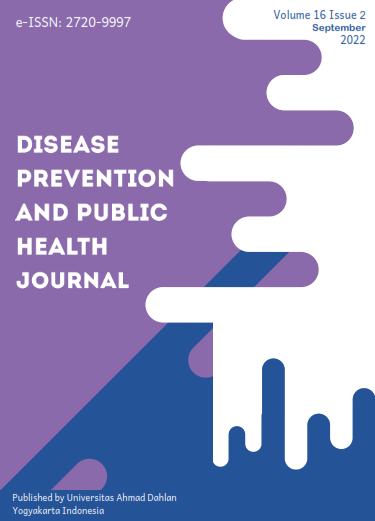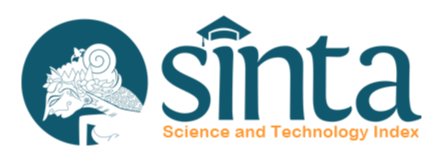Determinants of Adolescents' Desire to Quit Smoking in Indonesia: Data Analysis of the 2014 Global Youth Tobacco Survey
DOI:
https://doi.org/10.12928/dpphj.v16i2.4860Keywords:
teenager, determinant, cessation of smokingAbstract
Background: The high prevalence of smoking is not only among adults but also among children and adolescents. Almost all adolescent smokers wish to quit smoking. They are aware of the dangers of cigarettes, tobacco, and other types so they are motivated to quit smoking. This study aims to determine the determinants of the desire to quit smoking in Indonesian students, using a cross-sectional study design. Method: This study is a secondary data analysis of the Global Youth Tobacco Survey (GYTS) in Indonesia in 2014. The sample of the study was all students in grades 7-9 in Indonesia who participated in the 2014 GYTS and had complete data, namely 5,986 people. Logistic regression statistical test analysis was used to determine the relationship between the determinants and the desire to stop smoking in adolescents. Results: Adolescents who want to quit smoking are 92.1%. There is a relationship between adolescents who have tried cigarettes and other types of tobacco on the desire to stop smoking behavior (OR=11,3; 95% CI=5,216-24,615; p<0.025). There is a relationship between the dangers of smoking from family discussions on the behavior and desire of adolescents to stop smoking (OR=2,1; 95% CI=1,213-3,784; p<0.025). Conclusion: Family support and motivation can assist adolescents in reducing smoking habits by monitoring and reminding adolescents of the purpose of quitting smoking, and by inviting adolescents to consult and take therapy with Public Health Services.
References
Nardiello C, Morty RE. World No Tobacco Day 2020. Am J Physiol Lung Cell Mol Physiol. 2020 May 1;318(5):L1010-L1015. doi: 10.1152/ajplung.00110.2020. Epub 2020 Apr 1. PMID: 32233793.
Fouad H, Commar A, Hamadeh R, El-Awa F, Shen Z, Fraser C. Estimated and Projected Prevalence of Tobacco Smoking in Males, Eastern Mediterranean Region, 2000-2025. East Mediterr Health J. 2021 Jan 23;27(1):76-82. doi: 10.26719/2021.27.1.76. PMID: 33538322.
World Health Organization Regional Office for South-East Asia. Global Youth Tobacco Survey (GYTS): Indonesia Report 2014 [Internet]. Who-Searo. 2015. p. 92. Available from: http://www.searo.who.int/tobacco/data/ino_rtc_reports/en/%5Cnhttp://www.searo.who.int/tobacco/documents/ino_gyts_report_2014.pdf
Ahsan A, Wiyono NH, Veruswati M, Adani N, Kusuma D, Amalia N. Comparison of Tobacco Import and Tobacco Control in Five Countries: Lessons Learned for Indonesia. Global Health. 2020 Jul 18;16(1):65. doi: 10.1186/s12992-020-00595-y. PMID: 32682431; PMCID: PMC7368732.
Kristina SA, Permitasari NPAL, Krisnadewi KI, Santoso KA, Puspawati PR, Masrida WO, Andriani Y. Cancer Attributable to Tobacco Smoking in Member Countries of Association of Southeast Asian Nations (ASEAN) in Year 2018. Asian Pac J Cancer Prev. 2019 Oct 1;20(10):2909-2915. doi: 10.31557/APJCP.2019.20.10.2909. PMID: 31653134; PMCID: PMC6982657.
GYTS. Lembar Informasi Indonesia 2019 (Global Youth Tobacco Survei). World Heal Organ [Internet]. 2020;1–2. Available from: https://www.who.int/indonesia/news/events/world-no-tobacco-day-2020
Dewi LC, Hidayati L, Nastiti AA, Istifaizah N. Factors Affecting Smoking Cessation Among Adolescents - An Application of Theory of Planned Behavior. Proceedings of the 9th International Nursing Conference. 2019;(Inc):532–7. doi: https://doi.org/10.5220/0008328105320537
Conner M, Grogan S, Simms-Ellis R, Cowap L, Armitage CJ, West R, Marshall AM, Siddiqi K. Association Between Age at First Reported E-Cigarette Use and Subsequent Regular E-Cigarette, Ever Cigarette and Regular Cigarette Use. Addiction. 2021 Jul;116(7):1839-1847. doi: 10.1111/add.15386. Epub 2021 Jan 12. PMID: 33394523; PMCID: PMC8609424.
Melizza N, Kurnia AD, Masruroh N, Dewi LS. Smoking Behavior, Perceived Self-Efficacy, and Motivation of Smoking Cessation among University Student. Int J Health Sci (Qassim). 2020;8(01):23–9. doi: https://doi.org/10.14251/crisisonomy.2017.13.9.53
Lee HM, Hsu YH, Chen T. The Moderating Effects of Self-Referencing and Relational-Interdependent Self-Construal in Anti-Smoking Advertising for Adolescents. Int J Environ Res Public Health. 2020 Nov 16;17(22):8481. doi: 10.3390/ijerph17228481. PMID: 33207698; PMCID: PMC7698122.
WHO. Global Youth Tobacco Survey (GYTS): Indonesia report 2014 [Internet]. Who-Searo. 2015. 24 p. Available from: http://www.searo.who.int/tobacco/data/ino_rtc_reports/en/%5Cnhttp://www.searo.who.int/tobacco/documents/ino_gyts_report_2014.pdf
Nakaseko E, Kotera S, Nakazawa M. Factors Associated with Smoking and Drinking among Early Adolescents in Vanuatu: A Cross-Sectional Study of Adolescents and Their Parents. Int J Environ Res Public Health. 2020 Nov 13;17(22):8412. doi: 10.3390/ijerph17228412. PMID: 33202941; PMCID: PMC7697674.
Rios LE, Freire M do CM. Opinião de escolares adolescentes fumantes sobre aconselhamento e tratamento para cessação do tabagismo em serviços de saúde: estudo transversal, Goiás, 2018. Epidemiol e Serv saude Rev do Sist Unico Saude do Bras. 2020;29(4):e2019604. doi: https://doi.org/10.1590/scielopreprints.794
Budin CE, Râjnoveanu RM, Bordea IR, Grigorescu BL, Todea DA. Smoking in Teenagers from the Social Protection System-What Do We Know about It? Medicina (Kaunas). 2021 May 12;57(5):484. doi: 10.3390/medicina57050484. PMID: 34066069; PMCID: PMC8150939.
Buitenhuis AH, Tuinman MA, Hagedoorn M. A Planning Intervention to Quit Smoking in Single-Smoking Couples: Does Partner Involvement Improve Effectiveness? Psychol Health. 2021 Jan;36(1):1-15. doi: 10.1080/08870446.2019.1703983. Epub 2019 Dec 27. PMID: 31880171.
Kumar A, Tiwari A, Gadiyar A, Gaunkar RB, Kamat AK. Assessment of Readiness to Quit Tobacco Among Patients with Oral Potentially Malignant Disorders Using Transtheoretical Model. J Educ Health Promot. 2018 Jan 10;7:9. doi: 10.4103/jehp.jehp_75_17. PMID: 29417069; PMCID: PMC5791435.
Rogers E, Palacios J, Vargas E, Wysota C, Rosen M, Kyanko K, et al. Financial Hardship, Motivation to Quit and Post-Quit Spending Plans among Low-Income Smokers Enrolled in a Smoking Cessation Trial. Subst Abus Res Treat. 2019;13. doi: https://doi.org/10.1177/1178221819878765
Colston DC, Cho B, Thrasher JF, Titus AR, Xie Y, Emery S, Elliott MR, Fleischer NL. Anti-Smoking Media Campaigns and Disparities in Smoking Cessation in the United States, 2001-2015. Am J Health Promot. 2021 Jun;35(5):658-668. doi: 10.1177/0890117120985818. Epub 2021 Jan 8. PMID: 33415988; PMCID: PMC8362818.
Brown C, Nkemjika S, Yankey B, Okosun I. Alternative Tobacco Product Use and Smoking Quit Attempts Among Teenagers in the United States: A Cross-Sectional Study. Cureus. 2021 Jul 29;13(7):e16740. doi: 10.7759/cureus.16740. PMID: 34471583; PMCID: PMC8403058.
Rosen LJ, Rier DA, Schwartz R, Talitman M, Zwanziger L. Knowledge and Risk Perceptions of Israelis Towards Combustible Cigarettes: The Need for Immediate Remedial Action. Isr J Health Policy Res. 2019 Jan 14;8(1):10. doi: 10.1186/s13584-018-0276-2. PMID: 30642402; PMCID: PMC6330745.
Aziizah KN, Setiawan I, Lelyana S. Hubungan Tingkat Pengetahuan Tentang Dampak Rokok Terhadap Kesehatan Rongga Mulut dengan Tingkat Motivasi Berhenti Merokok pada Mahasiswa Universitas Kristen Maranatha. SONDE (Sound Dent. 2019;3(1):16–21. doi: https://doi.org/10.28932/sod.v3i1.1774
Chen X, Gu X, Li T, Liu Q, Xu L, Peng B, Wu N. Factors Influencing Smoking Behaviour of Online Ride-Hailing Drivers in China: A Cross-Sectional Analysis. BMC Public Health. 2021 Jul 6;21(1):1326. doi: 10.1186/s12889-021-11366-8. PMID: 34229627; PMCID: PMC8259384.
Wang TW, Gentzke AS, Creamer MLR, Cullen KA, Holder-Hayes E, Sawdey MD, et al. Tobacco Product Use and Associated Factors Among Middle and High School Students-United States, 2019. MMWR Surveill Summ. 2019;68(12). doi: https://doi.org/10.15585/mmwr.ss6812a1
Warner LM, Stadler G, Lüscher J, Knoll N, Ochsner S, Hornung R, Scholz U. Day-to-day Mastery and Self-Efficacy Changes During a Smoking Quit Attempt: Two Studies. Br J Health Psychol. 2018 May;23(2):371-386. doi: 10.1111/bjhp.12293. Epub 2018 Jan 15. PMID: 29333730.
Pinsker EA, Hennrikus DJ, Erickson DJ, Call KT, Forster JL, Okuyemi KS. Trends in Self-Efficacy to Quit and Smoking Urges Among Homeless Smokers Participating in a Smoking Cessation RCT. Addict Behav. 2018 Mar;78:43-50. doi: 10.1016/j.addbeh.2017.10.025. Epub 2017 Nov 2. PMID: 29125976; PMCID: PMC5783755.
Kashyap VK, Dhasmana A, Massey A, Kotnala S, Zafar N, Jaggi M, Yallapu MM, Chauhan SC. Smoking and COVID-19: Adding Fuel to the Flame. Int J Mol Sci. 2020 Sep 9;21(18):6581. doi: 10.3390/ijms21186581. PMID: 32916821; PMCID: PMC7555793.
Ng'ombe JN, Nedson NR, Tembo NFP. "Look at Me, I Plan to Quit Smoking": Bayesian Hierarchical Analysis of Adolescent Smokers' Intention to Quit Smoking. Healthcare (Basel). 2020 Mar 27;8(2):76. doi: 10.3390/healthcare8020076. PMID: 32230923; PMCID: PMC7349091.
Wong C, Lucas B, Sungono V, Kurniawan A, Widysanto A. Correlation Between The Knowledge On Health Effects Of Smoking And Motivation On Smoking Cessation In Ex-Smokers Of Lung Department Patients, Siloam General Hospital, Lippo Village. Medicinus. 2021;8(2):38. doi: https://doi.org/10.19166/med.v8i2.3435
Trofor AC, Papadakis S, Lotrean LM, Radu-Loghin C, Eremia M, Mihaltan F, et al. Knowledge of the health risks of smoking and impact of cigarette warning labels among tobacco users in six European countries: Findings from the EUREST-PLUS ITC Europe Surveys. Tob Induc Dis. 2018;16(July):1–13. doi: https://doi.org/10.18332/tid/99542
Jackson SE, Proudfoot H, Brown J, East K, Hitchman SC, Shahab L. Perceived Non-Smoking Norms and Motivation to Stop Smoking, Quit Attempts, and Cessation: A Cross-Sectional Study in England. Sci Rep. 2020 Jun 26;10(1):10487. doi: 10.1038/s41598-020-67003-8. PMID: 32591555; PMCID: PMC7320183.
Downloads
Published
Issue
Section
License
Copyright (c) 2022 Universitas Ahmad Dahlan

This work is licensed under a Creative Commons Attribution-ShareAlike 4.0 International License.
Authors transfer the copyright and grant the Disease Prevention and Public Health Journal right of first publication with the work simultaneously licensed under a Creative Commons Attribution License (CC BY-SA 4.0) that allows others to share (copy and redistribute the material in any medium or format) and adapt (remix, transform, and build upon the material) the work for any purpose, even commercially with an acknowledgement of the work's authorship and initial publication in Disease Prevention and Public Health Journal. Authors are able to enter into separate, additional contractual arrangements for the non-exclusive distribution of the journal's published version of the work (e.g., post it to an institutional repository or publish it in a book), with an acknowledgement of its initial publication in Disease Prevention and Public Health Journal. Authors are permitted and encouraged to post their work online (e.g., in institutional repositories or on their website) prior to and during the submission process, as it can lead to productive exchanges, as well as earlier and greater citation of published work (See The Effect of Open Access).

This work is licensed under a Creative Commons Attribution-ShareAlike 4.0 International License.







